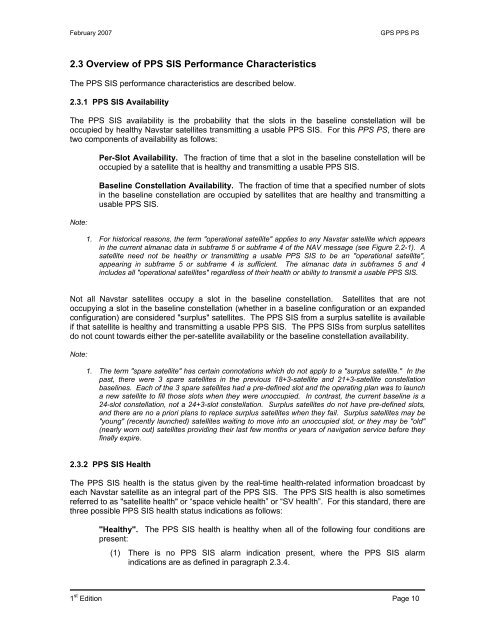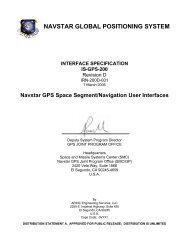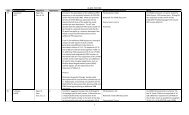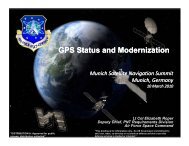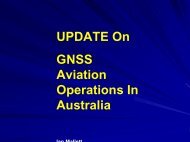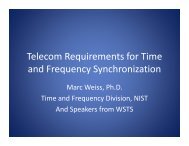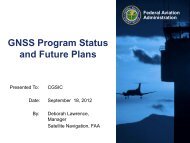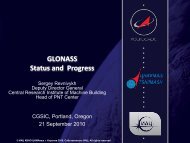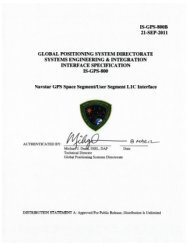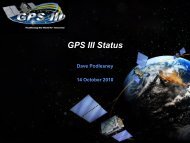Precise Positioning Service Performance Standard - GPS.gov
Precise Positioning Service Performance Standard - GPS.gov
Precise Positioning Service Performance Standard - GPS.gov
Create successful ePaper yourself
Turn your PDF publications into a flip-book with our unique Google optimized e-Paper software.
February 2007<br />
<strong>GPS</strong> PPS PS<br />
2.3 Overview of PPS SIS <strong>Performance</strong> Characteristics<br />
The PPS SIS performance characteristics are described below.<br />
2.3.1 PPS SIS Availability<br />
The PPS SIS availability is the probability that the slots in the baseline constellation will be<br />
occupied by healthy Navstar satellites transmitting a usable PPS SIS. For this PPS PS, there are<br />
two components of availability as follows:<br />
Note:<br />
Per-Slot Availability. The fraction of time that a slot in the baseline constellation will be<br />
occupied by a satellite that is healthy and transmitting a usable PPS SIS.<br />
Baseline Constellation Availability. The fraction of time that a specified number of slots<br />
in the baseline constellation are occupied by satellites that are healthy and transmitting a<br />
usable PPS SIS.<br />
1. For historical reasons, the term "operational satellite" applies to any Navstar satellite which appears<br />
in the current almanac data in subframe 5 or subframe 4 of the NAV message (see Figure 2.2-1). A<br />
satellite need not be healthy or transmitting a usable PPS SIS to be an "operational satellite",<br />
appearing in subframe 5 or subframe 4 is sufficient. The almanac data in subframes 5 and 4<br />
includes all "operational satellites" regardless of their health or ability to transmit a usable PPS SIS.<br />
Not all Navstar satellites occupy a slot in the baseline constellation. Satellites that are not<br />
occupying a slot in the baseline constellation (whether in a baseline configuration or an expanded<br />
configuration) are considered "surplus" satellites. The PPS SIS from a surplus satellite is available<br />
if that satellite is healthy and transmitting a usable PPS SIS. The PPS SISs from surplus satellites<br />
do not count towards either the per-satellite availability or the baseline constellation availability.<br />
Note:<br />
1. The term "spare satellite" has certain connotations which do not apply to a "surplus satellite." In the<br />
past, there were 3 spare satellites in the previous 18+3-satellite and 21+3-satellite constellation<br />
baselines. Each of the 3 spare satellites had a pre-defined slot and the operating plan was to launch<br />
a new satellite to fill those slots when they were unoccupied. In contrast, the current baseline is a<br />
24-slot constellation, not a 24+3-slot constellation. Surplus satellites do not have pre-defined slots,<br />
and there are no a priori plans to replace surplus satellites when they fail. Surplus satellites may be<br />
"young" (recently launched) satellites waiting to move into an unoccupied slot, or they may be "old"<br />
(nearly worn out) satellites providing their last few months or years of navigation service before they<br />
finally expire.<br />
2.3.2 PPS SIS Health<br />
The PPS SIS health is the status given by the real-time health-related information broadcast by<br />
each Navstar satellite as an integral part of the PPS SIS. The PPS SIS health is also sometimes<br />
referred to as "satellite health" or “space vehicle health” or “SV health”. For this standard, there are<br />
three possible PPS SIS health status indications as follows:<br />
"Healthy". The PPS SIS health is healthy when all of the following four conditions are<br />
present:<br />
(1) There is no PPS SIS alarm indication present, where the PPS SIS alarm<br />
indications are as defined in paragraph 2.3.4.<br />
1 st Edition Page 10


